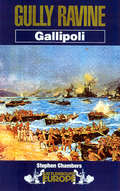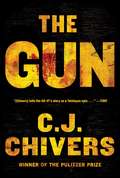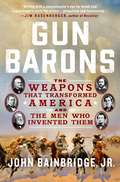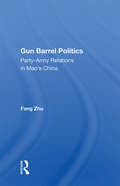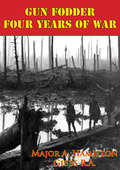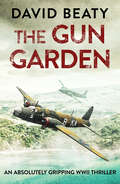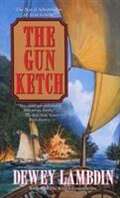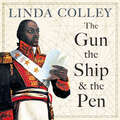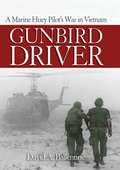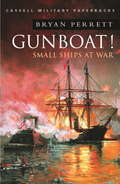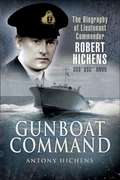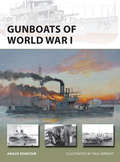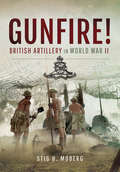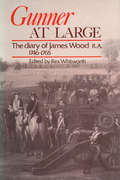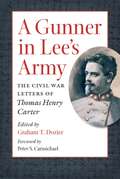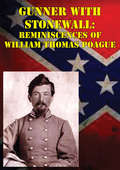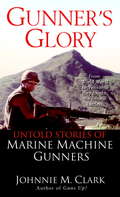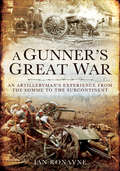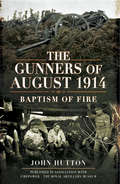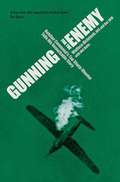- Table View
- List View
Gulf War and Health: Update of Health Effects of Serving in the Gulf War, 2016
by National Academies of Sciences Engineering MedicineFor the United States, the 1991 Persian Gulf War was a brief and successful military operation with few injuries and deaths. However, soon after returning from duty, a large number of veterans began reporting health problems they believed were associated with their service in the Gulf. At the request of Congress, the Institute of Medicine (IOM) has been conducting an ongoing review of the evidence to determine veterans' long-term health problems and potential causes. The fourth volume in the series, released in 2006, summarizes the long-term health problems seen in Gulf War veterans. In 2010, the IOM released an update that focuses on existing health problems and identifies possible new ones, considering evidence collected since the initial summary. Gulf War and Health: Volume 10, the final volume of the series, is an update of the scientific and medical literature on the health effects associated with deployment to the Gulf War that were identified in Volumes 4 and 8. This report reviews and evaluates the associations between illness and exposure to toxic agents, environmental or wartime hazards, or preventive measures and vaccines associated with Gulf War service, and provides recommendations for future research efforts on Gulf War veterans.
Gulf War and Health: Volume 11: Generational Health Effects Of Serving In The Gulf War
by National Academies of Sciences Engineering MedicineFor the United States, the 1991 Persian Gulf War was a brief and successful military operation with few injuries and deaths. However, soon after returning from duty, a large number of veterans began reporting health problems they believed were associated with their service in the Gulf. At the request of Congress, the National Academies of Sciences, Engineering, and Medicine has been conducting an ongoing review of the evidence to determine veterans' long-term health problems and potential causes. Some of the health effects identified by past reports include post-traumatic stress disorders, other mental health disorders, Gulf War illness, respiratory effects, and self-reported sexual dysfunction. Veterans’ concerns regarding the impacts of deployment-related exposures on their health have grown to include potential adverse effects on the health of their children and grandchildren. These concerns now increasingly involve female veterans, as more women join the military and are deployed to war zones and areas that pose potential hazards. Gulf War and Health: Volume 11 evaluates the scientific and medical literature on reproductive and developmental effects and health outcomes associated with Gulf War and Post-9/11 exposures, and designates research areas requiring further scientific study on potential health effects in the descendants of veterans of any era.
The Gulf War of 1991 Reconsidered (Besa Studies In International Security)
by Andrew J. BacevichThe Gulf War of 1991 Reconsidered subjects one of the formative events of the post-Cold War era and a watershed in Middle Eastern international politics to a comprehensive reassessment. Condidering events from Arab, Israeli and American view points, the book examines the Gulf War's historical origins, conduct and legacy.
Gully Ravine: Gallipoli (Battleground Europe)
by Stephen ChambersThis book concentrates on Gully Ravine and its immediate area on the western side of the Helles battlefield. Here trench fighting raged throughout the campaign, culminating in the Battle of Gully Ravine between 28 June and 5 July 1915. This attack was a successful piece of planning and execution, enabling the British to capture five lines of Turkish trenches, seriously threatening the Turkish hold on the southern tip of the peninsula. After this attack the region fell into the deadlock of trench warfare, which brought its horrors as well as its monotony. This beautiful and picturesque area of Gallipoli is seldom visited, and its part in the campaign almost forgotten. The book is well researched and contains a high proportion of original photographs and maps, which have never been published before.
The Gun: The AK-47 and the Evolution of War
by C. J. ChiversAt a secret arms-design contest in Stalin's Soviet Union, army technicians submitted a stubby rifle with a curved magazine. Dubbed the AK-47, it was selected as the Eastern Bloc's standard arm. Scoffed at in the Pentagon as crude and unimpressive, it was in fact a breakthrough--a compact automatic that could be mastered by almost anyone, last decades in the field, and would rarely jam. Manufactured by tens of millions in planned economies, it became first an instrument of repression and then the most lethal weapon of the Cold War. Soon it was in the hands of terrorists.In a searing examination of modern conflict and official folly, C. J. Chivers mixes meticulous historical research, investigative reporting, and battlefield reportage to illuminate the origins of the world's most abundant firearm and the consequences of its spread. The result, a tour de force of history and storytelling, sweeps through the miniaturization and distribution of automatic firepower, and puts an iconic object in fuller context than ever before. The Gun dismantles myths as it moves from the naïve optimism of the Industrial Revolution through the treacherous milieu of the Soviet Union to the inside records of the Taliban. Chivers tells of the 19th-century inventor in Indianapolis who designs a Civil War killing machine, insisting that more-efficient slaughter will save lives. A German attaché who observes British machine guns killing Islamic warriors along the Nile advises his government to amass the weapons that would later flatten British ranks in World War I. In communist Hungary, a locksmith acquires an AK-47 to help wrest his country from the Kremlin's yoke, beginning a journey to the gallows. The Pentagon suppresses the results of firing tests on severed human heads that might have prevented faulty rifles from being rushed to G.I.s in Vietnam. In Africa, a millennial madman arms abducted children and turns them on their neighbors, setting his country ablaze. Neither pro-gun nor anti-gun, The Gun builds to a terrifying sequence, in which a young man who confronts a trio of assassins is shattered by 23 bullets at close range. The man survives to ask questions that Chivers examines with rigor and flair.Throughout, The Gun animates unforgettable characters--inventors, salesmen, heroes, megalomaniacs, racists, dictators, gunrunners, terrorists, child soldiers, government careerists, and fools. Drawing from years of research, interviews, and from declassified records revealed for the first time, he presents a richly human account of an evolution in the very experience of war.
Gun Barons: The Weapons That Transformed America and the Men Who Invented Them
by John Bainbridge Jr.John Bainbridge, Jr.'s Gun Barons is a narrative history of six charismatic and idiosyncratic men who changed the course of American history through the invention and refinement of repeating weapons.Love them or hate them, guns are woven deeply into the American soul. Names like Colt, Smith & Wesson, Winchester, and Remington are legendary. Yet few people are aware of the roles these men played at a crucial time in United States history, from westward expansion in the 1840s, through the Civil War, and into the dawn of the Gilded Age. Through personal drive and fueled by bloodshed, they helped propel the young country into the forefront of the world's industrial powers.Their creations helped save a nation divided, while planting seeds that would divide the country again a century later. Their inventions embodied an intoxicating thread of American individualism—part fiction, part reality—that remains the foundation of modern gun culture. They promoted guns not only for the soldier, but for the Everyman, and also made themselves wealthy beyond their most fevered dreams.Gun Barons captures how their bold inventiveness dwelled in the psyche of an entire people, not just in the minds of men who made firearm fortunes. Whether we revere these larger-than-life men or vilify them, they helped forge the American character.
Gun Barrel Politics: Party-army Relations In Mao's China
by Fang ZhuThis book tests the model of civil-military dualism to explain People's Liberation Army's (PLA) political engagement and its loyalty to the party in Maoist China. It explores how the party maintained its control— through penetration of the armed forces or non-intervention and civilian control.
Gun Fodder - Four Years Of War [Illustrated Edition]
by Major A. Hamilton Gibbs R.A.Includes the First World War Illustrations Pack - 73 battle plans and diagrams and 198 photosMemoirs of an officer, brother of the war correspondent, Philip Gibbs, who enlisted as a trooper in 9th Lancers, was commissioned into the Royal Artillery at the end of 1914, then served in Salonika and on the Western front.
The Gun Garden
by David BeatyA young Royal Air Force Pilot is sent on a dangerous mission in Malta in this WWII novel of love and war. Malta, 1942. As the Second World War rages, the strategically vital Mediterranean island of Malta is isolated, desperately short of supplies, and slowly being starved into surrender. Into this hopeless situation, the British send two Wellington aircraft equipped with secret long-range radar. Their role is to find enemy convoys proceeding at night from Italy to Africa, and to lead a tiny naval force through the darkness to their unsuspecting target. One is captained by a veteran R.A.F. pilot, the other is flown by Peter Forrester, a young and hastily trained kid is about to have his carefree spirit tested by the maelstrom of war. Thrown into this island of heroes, Peter also meets Miranda Black, daughter of a naval captain and a plotter in Barracca H.Q. Written by acclaimed author and R.A.F. veteran David Beaty, The Gun Garden is an authentic tale of gritty battle and young love.
The Gun Ketch: The Naval Adventures of Alan Lewrie (The Naval Adventures of Alan Lewrie #5)
by Dewey LambdinA fighter, rogue, and ladies man, Alan Lewrie has done the unthinkable and gotten himself hitched—to a woman and a ship! The woman is the lovely Caroline Chiswick. The ship is the gun ketch Alacrity, bound for the Bahamas and a bloody game of cat and mouse with the pirates who ply the lunatic winds there. But while war comes naturally to the young husband, politics doesn't. Sure that a powerful Bahamian merchant is behind a scourge of piracy, Lewrie runs afoul of the Royal Governor--who holds the most precious hostage of all.... From the windswept Carolinas to the exotic East Indies, Alan Lewrie fights and frolics with all the wild abandon of the high seas themselves. He's a true swashbuckling naval hero in the age of great sailing ships.
Gun Shy: The True Story of the Army Dog Scared of War
by Alison Stokes Angie McDonellVidar, the army search dog, has spent half his life sniffing out enemy weapons and bombs on the front line of the war in Afghanistan. His keen nose saved the lives of hundreds of soldiers, finding roadside bombs which could have killed British troops. But after two years of loyal service, Vidar became ‘Gun Shy’ – a term used to describe dogs who are frightened of loud noises. Whenever he heard bombs exploding or even the sound of helicopters flying above, he would curl up in the corner, shaking with fear.His army days were numbered… and his future looked uncertain. Until Angie, an army medic who befriended him during her tour of Afghanistan, made it her duty to give him a safe haven at her Welsh home.
The Gun, the Ship and the Pen: Warfare, Constitutions and the Making of the Modern World
by Linda Colley'If there were a Nobel Prize in History, Colley would be my nominee' Jill Lepore, New Yorker'One of the most exciting historians of her generation, but also one of the most interesting writers of non-fiction around' - William Dalrymple, Guardian'Colley takes you on intellectual journeys you wouldn't think to take on your own, and when you arrive you wonder that you never did it before' - David Aaronovitch, the Times'A global history of remarkable depth, imagination and insight' Tony Barber, Financial Times Summer BooksStarting not with the United States, but with the Corsican constitution of 1755, The Gun, the Ship, and the Pen moves through every continent, disrupting accepted narratives. Both monarchs and radicals play a role, from Catherine the Great of Russia, with her remarkable Nakaz, to Sierra Leone's James Africanus Horton, to Tunisia's Khayr-al-Din, a creator of the first modern Islamic constitution. Throughout, Colley demonstrates how constitutions evolved in tandem with warfare, and how they have functioned to advance empire as well as promote nations, and worked to exclude aswell as liberate.Whether reinterpreting Japan's momentous 1889 constitution, or exploring the significance of the first constitution to enfranchise all adult women on Pitcairn Island in the Pacific in 1838, this is one of the most original global histories in decades.
Gunbird Driver
by David A. BallentineGunbird Driver is a memoir of the Vietnam War as seen through the eyes of a young pilot flying an armed UH-1E's in Marine Observation Squadron 6. The book provides information about the missions, operations, and the living conditions at Ky Ha, and about the fellow Marines with whom he served. It also contains several chapters on shipboard operation from deployment aboard the USS Princeton. Parts of the book are deadly serious, even sad, as must be the case with any treatment of war; other parts are largely descriptive, and some circumstances and situations are even humorous. The time was 1966-67, relatively early in the war, the year before the Tet Offensive. The squadron's activities ranged widely in I Corps, the northern-most military subdivision of South Vietnam, the one assigned to the Marines. Although, the squadron and the air group to which it was attached (MAG -36) was assigned to the southern third of I Corps, it flew missions north along the DMZ, at Khe Sanh, west of Phu Bai and even into Laos, in addition to those in their local Tactical Area of Responsibility. Written to preserve a record of the impressions and experiences of one young 1st Lieutenant flying a Marine Huey in the war-torn skies of Vietnam, it is also reflective of all who crewed the UH-1E's - pilots, crew chiefs, and door gunners. It is a memoir that will resonate with all who crewed a "helo" in during the Vietnam war. No other book has been written on the Vietnam War from the perspective of a Marine Corps UH-1E pilot, flying armed escort missions for the Marines fighting the war on the ground.
Gunboat!: Small Ships At War (Sven Hassel War Classics)
by Bryan PerrettThis is naval action adventure with a difference - thirteen naval engagements in which gunboats won the day against every kind of enemy, large and smallBritain, like other colonial powers, established, controlled and accessed her empire from the seas. It was realised that the preservation of secure trading conditions required armed ships able to operate in shallow coastal and river waters. The gunboat was developed to meet this need: a small, shallow-draft, steam-powered screw or paddle driven vessel, sufficiently fast and manoeuvrable to take the enemy, whether on shore or afloat, by surprise.In this book Bryan Perrett recounts thirteen episodes of exciting gunboat action, ranging from the Burma war in 1824, through two world wars and on to the dramatic escape of the Amethyst down the Yangtze in 1949.
Gunboat Command: The Biography of Lieutenant Commander Robert Hichens DSO* DSC** RNVR
by Antony HichensThis biography draws heavily on the personal diaries of the subject, Robert Hichens (or Hitch as he was universally known).After a brief description of his early life, time at Oxford, his motor racing achievements (including trophies at Le Mans in his Aston Martin) and RN training, the book focuses on his exceptional wartime experiences. Hitch was the most highly decorated RNVR officer of the war with two DSOs, three DSCs and three Mentions in Despatches. He was recommended for a posthumous VC. We read of his early days in vulnerable minesweepers and the Dunkirk Dynamo operation, (his first DSC).In late 1940 he joined Coastal Forces serving in the very fast MGBs, soon earning his own command and shortly after command of his Flotilla. He was the first to capture an E-Boat. His successful leadership led to many more successes and his reputation as a fearless and dynamic leader remains a legend today.The book contains detailed and graphic accounts of running battles against the more heavily armed E-boats. Tragically he was killed in action in April 1943, having refused promotion and a job ashore.
Gunboat!: Small Ships At War
by Bryan PerrettThis is naval action adventure with a difference - thirteen naval engagements in which gunboats won the day against every kind of enemy, large and smallBritain, like other colonial powers, established, controlled and accessed her empire from the seas. It was realised that the preservation of secure trading conditions required armed ships able to operate in shallow coastal and river waters. The gunboat was developed to meet this need: a small, shallow-draft, steam-powered screw or paddle driven vessel, sufficiently fast and manoeuvrable to take the enemy, whether on shore or afloat, by surprise.In this book Bryan Perrett recounts thirteen episodes of exciting gunboat action, ranging from the Burma war in 1824, through two world wars and on to the dramatic escape of the Amethyst down the Yangtze in 1949.
Gunboats of World War I
by Angus KonstamFrom the Mediterranean to the Black Sea, from the Balkans to Mesopotamia, gunboats played an influential part in the story of World War I. This detailed technical guide to the gunboats of all the major navies of the war means that, for the first time, the story can be told. Naval action in World War I conjures up images of enormous dreadnoughts slugging it out in vast oceans. Yet the truth is that more sailors were killed serving on gunboats and monitors operating far from the naval epicentre of the war than were ever killed at Jutland. Gunboat engagements during this war were bloody and hard fought, if small in scale. Austrian gunboats on the Danube fired the first shots of the war, whilst German, British and Belgian gunboats fought one of the strangest, most intriguing naval campaigns in history in far-flung Lake Tanganyika.
Gunfire!: British Artillery in World War II
by Stig H. MobergThis book provides an insight into how artillery resources were established, developed and employed during the Second World War, using the British Royal Artillery as an example. Beginning with an overview of the nature and state of readiness of the Royal Artillery on the outbreak of war, the book analyses in great detail the weapons available to the Royal Artillery, their technical functionality and their performance capabilities. With this knowledge the author then examines the organization, methods, procedures and tactics employed by the Royal Artillery. To complete this fascinating study, Stig Moberg looks at a number of key battles from the war to see how the artillery was used, and the effectiveness of its support to the British and Allied infantry, in campaigns in North Africa, Burma and Europe. British Artillery of the Second World War is profusely illustrated throughout with photographs, maps, plans, graphs, charts and diagrams to demonstrate precisely how the British Artillery was used on the battlefields around the world. Although I am an infantryman, and proud of it, I have many times said that the Royal Regiment of Artillery, in my opinion, did more to win the last war, more than any other Arm of the Service.Field Marshal Bernard Montgomery
Gunner at Large: The Diary of James Wood R.A. 1746-1765
by Rex WhitworthJames Wood was one of the first trained at Woolwich and served successively as a Volunteer, Mattross, Cadet, Cadet Gunner and Fireworker in France, the Low Countries, Scotland and India.
A Gunner in Lee's Army
by Peter S. Carmichael Graham DozierIn May 1861, Virginian Thomas Henry Carter (1831-1908) raised an artillery battery and joined the Confederate army. Over the next four years, he rose steadily in rank from captain to colonel, placing him among the senior artillerists in Robert E. Lee's Army of Northern Virginia. During the war, Carter wrote more than 100 revealing letters to his wife, Susan, about his service. His interactions with prominent officers--including Lee, Jubal A. Early, John B. Gordon, Robert E. Rodes, and others--come to life in Carter's astute comments about their conduct and personalities. Combining insightful observations on military operations, particularly of the Battles of Antietam and Spotsylvania Court House and the 1864 Shenandoah Valley Campaign, with revealing notes on the home front and the debate over the impressment and arming of slaves, Carter's letters are particularly interesting because his writing is not overly burdened by the rhetoric of the southern ruling class.Here, Graham Dozier offers the definitive edition of Carter's letters, meticulously transcribed and carefully annotated. This impressive collection provides a wealth of Carter's unvarnished opinions of the people and events that shaped his wartime experience, shedding new light on Lee's army and Confederate life in Virginia.
Gunner with Stonewall: Reminiscences Of William Thomas Poague [Illustrated Edition]
by Bell Irvin Wiley Monroe F. Cockrell Lt.-Col. William Thomas PaogueIncludes Civil War Map and Illustrations Pack - 224 battle plans, campaign maps and detailed analyses of actions spanning the entire period of hostilities.An excellent memoir from one of Stonewall Jackson's artillery officers who fought throughout the Civil War until final defeat.Born in Rockbridge County, Virginia in 1835, the opening of the Civil War found William T. Poague practicing law in Missouri. As the first shots began flying he repaired to his home state to offer his services to the Confederate army. He started his army life as a second lieutenant in the famous Rockbridge Virginia Artillery and would fight with gallantry, courage and great skill on many Civil War battlefields. He was engaged at First Manassas, Romney, Kernstown, the Seven Days Campaign, Cedar Mountain, Second Manassas, Harper's Ferry Antietam, and Fredericksberg. By this time his distinguished conduct had led him to be promoted to Major and fought on at Chancellorsville, Gettysburg, the Wilderness, Cold Harbor before the final surrender at Appomattox.This edition was edited by noted Civil War historian Monroe F. Cockerell and has an excellent introduction by Bell Irwin Wiley.
Gunner's Glory: Untold Stories of Marine Machine Gunners
by Johnnie ClarkThey were warriors, trained to fight, dedicated to their country, and determined to win. At Guadalcanal, the Marine Corps' machine gunners took everything the Japanese could throw at them in one of the bloodiest battles of World War II; their position was so hopeless that at one point they were given the go-ahead to surrender. Near the Chosin Reservoir in Korea, as the mercury dropped to twenty below, the 1st Marine Division found itself surrounded and cut off by the enemy. The outlook seemed so bleak that many in Washington had privately written off the men. But surrender is not part of a Marine's vocabulary. Gunner's Glorycontains true stories of these and other tough battles in the Pacific, in Korea, and in Vietnam, recounted by the machine gunners who fought them. Bloody, wounded, sometimes barely alive, they stayed with their guns, delivering a stream of firepower that often turned defeat into victory-andalwaysmade them the enemy's first target. From the Paperback edition.
A Gunner's Great War: An Artilleryman's Experience from the Somme to the Subcontinent
by Ian RonayneIf the First World War had not happened when it did, Channel Islander Clarence Ahier would almost certainly have led a mostly unremarkable life. But it did, and in October 1915, aged just 23-years-old, Clarence left his home and volunteered to join the British Army. He would spend the next two and half years serving as an artillery man on the Western Front.Now this in itself is not remarkable—millions of other young men did the same thing. But Clarence Ahier did do something remarkable, and it was something to set him out from almost all his contemporaries. From the very beginning of his time at the front, he wrote a graphic and moving account of his experiences of war.Clarences ultimate plans for his meticulously written journal are unknown. But having lain unnoticed for years, it was recently discovered in a collection of dusty ephemera handed to a local history society.The complete journal consists of around 25,000 words, with a focus on Clarences experience during the Battle of the Somme, in the fighting around Ypres, and, after he was wounded for the second time, the journey to India and his time there as a member of the garrison. This will be supported by additional explanatory text.
The Gunners of August 1914: Baptism of Fire
by John HuttonThe Great War will always be synonymous with trench warfare and the mass slaughter inflicted by machine guns on the helpless but gallant infantry. There is a good reason for this view as the machine guns took a terrible toll, and the infantry's experiences continue to fascinate and appal people today. But one aspect of the fighting that gets insufficient attention is the artillery. Histories of the major battles often reduce the role of the big guns to a few paragraphs, and this has created a seriously distorted impression of the reality of the fighting. A better balance needs to be struck, and that is the intention of John Hutton's new book on the gunners of 1914.He tells the story of the war as the gunners themselves saw it, focusing on the first few months of warfare which were fundamental to the conduct of the campaign. The gunners may not have always shared the trench experiences of the infantry in the front line, but they were in the thick of the action, and success or failure depended on them. The personal testimonies of those who served with and supported the guns provide a vital insight into the colossal tragedy and drama of the war from the artilleryman's point of view.
Gunning for the Enemy: Bomber Command's Top Sharp-Shooter Tells His Remarkable Story
by Wallace McIntosh Mel RolfeThe World War II exploits of the legendary RAF air gunner, &“a true hero who repeatedly cheated death,&” from the author of Flying into Hell (The Times). Born into grinding poverty in Scotland, Wallace McIntosh had not heard of Christmas until he was seven, and never celebrated his birthday until his late teens, but he could steal, kill and skin a sheep before he was twelve and snare anything that could be cooked in a pot. Leaving school at thirteen he was determined to escape the constant struggle to survive. Gunning for the Enemy tells the moving story of how the RAF finally accepted McIntosh after at first rejecting him, but then initially gave him the lowliest of jobs. Only by a fluke was he trained as an air gunner. During his time with 207 Squadron, based at Langar, Nottinghamshire and Spilsby, Lincolnshire, he flew over fifty sorties in World War Two. Although Bomber Command did not record details of &“kills&” by air gunners, Wallace, who shot down eight enemy aircraft with one probable, is widely believed to be its top sharpshooter and at one time he was its most decorated also. He had many hairy incidents and his prodigious memory for detail enables him to recall numerous amazing escapes from death and how each and every night he and his comrades dramatically took the war to the enemy. This is a story of outstanding courage, told with wit, pace and honesty by Mel Rolfe who has previously enjoyed acclaim with such books as To Hell and Back, Hell on Earth and Flying into Hell.



